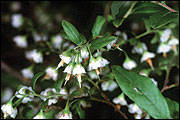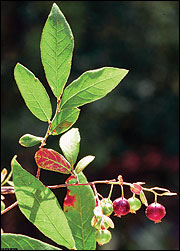Huckleberry
- Vaccinium spp.
- Blueberry, Deerberry, Farkleberry
Woody
 Vacciniums are stiff-branched shrubs from 6 inches to 10 feet tall.
Vacciniums are stiff-branched shrubs from 6 inches to 10 feet tall.
©James H. Miller, USDA-NRCS Plants Database
Description
Vacciniums are stiffly branched leafy shrubs or small trees, often found in extensive colonies, from 6 inches to 10 feet tall. Although uncommon in some regions, they occur throughout the Midwest, often on acid soils overlying sandstone, chert or igneous bedrock of dry open woods, glades, ridges and upland slopes. The alternate, simple leaves are 3/4 to 3 inches long and 1/2 to 1 inch wide. The fruits are blue to black berries with a faint whitish coating and are sweet and palatable. The fruits contain as many as five seeds and mature from late June through August.
Bloom period
April to June
Use by bobwhites
Huckleberry fruits are a staple in the diets of many wildlife species and are consumed frequently by bobwhites and other songbirds. The seeds will persist well into winter, when other preferred food sources become scarce. Dense colonies may provide summer thermal and escape cover.




